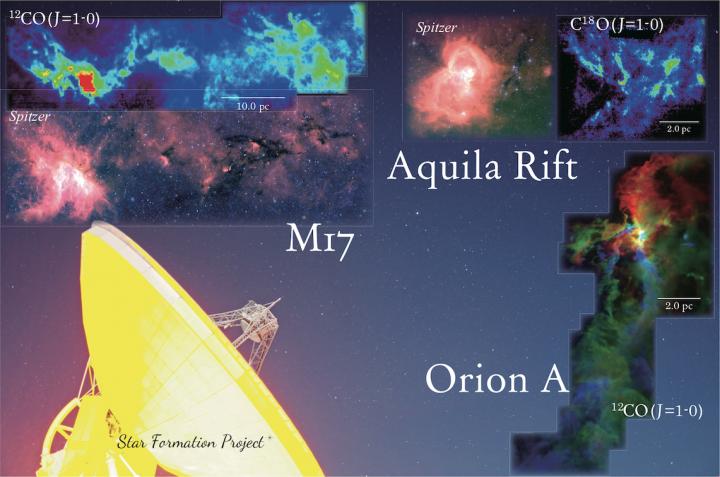
Credit: NAOJ
Astronomers have captured new, detailed maps of three nearby interstellar gas clouds containing regions of ongoing high-mass star formation. The results of this survey, called the Star Formation Project, will help improve our understanding of the star formation process.
We know that stars such as the Sun are born from interstellar gas clouds. These interstellar gas clouds are difficult to observe in visible light, but emit strong radio wavelength, which can be observed by the Nobeyama 45-m Radio Telescope in Japan. A research team led by Fumitaka Nakamura, an Assistant Professor at the National Astronomical Observatory of Japan (NAOJ), used the telescope to create detailed radio maps of interstellar gas clouds, the birthplaces of stars. The team including members from NAOJ, the University of Tokyo, Tokyo Gakugei University, Ibaraki University, Otsuma Women’s University, Niigata University, Nagoya City University, and other universities, will use the observational data to investigate the star formation process.
The team targeted three interstellar clouds: the Orion A, Aquila Rift, and M17 regions. For the Orion A region, the group collaborated with the CARMA interferometer in the United States, combining their data to create the most detailed map ever of the region. The resultant map has a spatial resolution of about 3200 astronomical units. This means that the map can reveal details as small as 60 times the size of the Solar System.
Even the world’s most powerful radio telescope, the Atacama Large Millimeter/submillimeter Array (ALMA), could not obtain a similar large-scale map of Orion A because of ALMA’s limited field-of-view and observation time constraints. But ALMA can investigate more distant interstellar clouds. Therefore, this large-scale, most-detailed radio map of the Orion A gas cloud obtained by the Star Formation Project is complementary with other observational research.
###
Media Contact
Dr. Kenzo Kinugasa
[email protected]
Original Source
https:/
Related Journal Article
http://dx.




